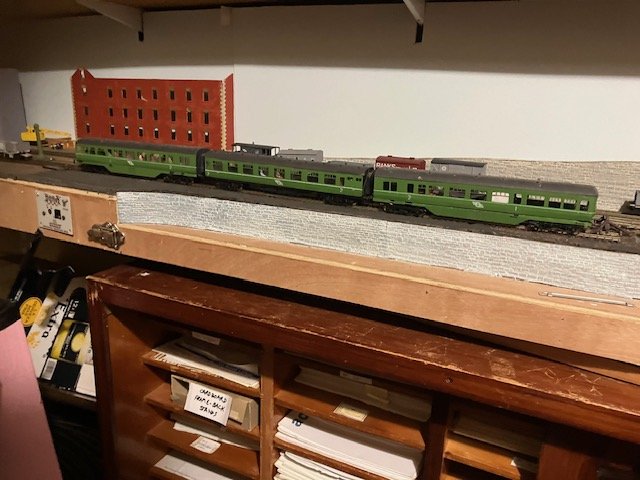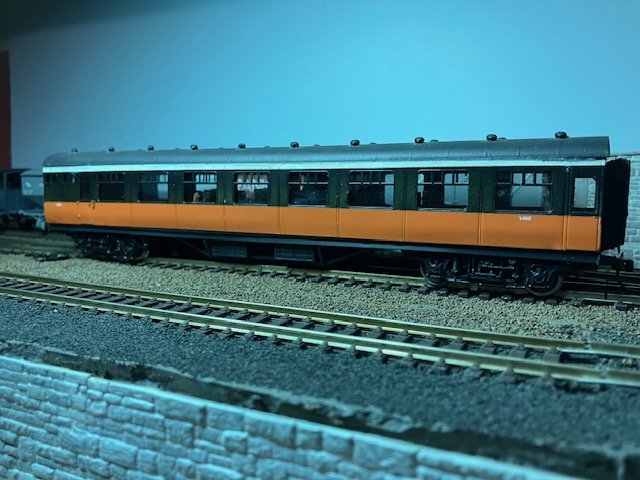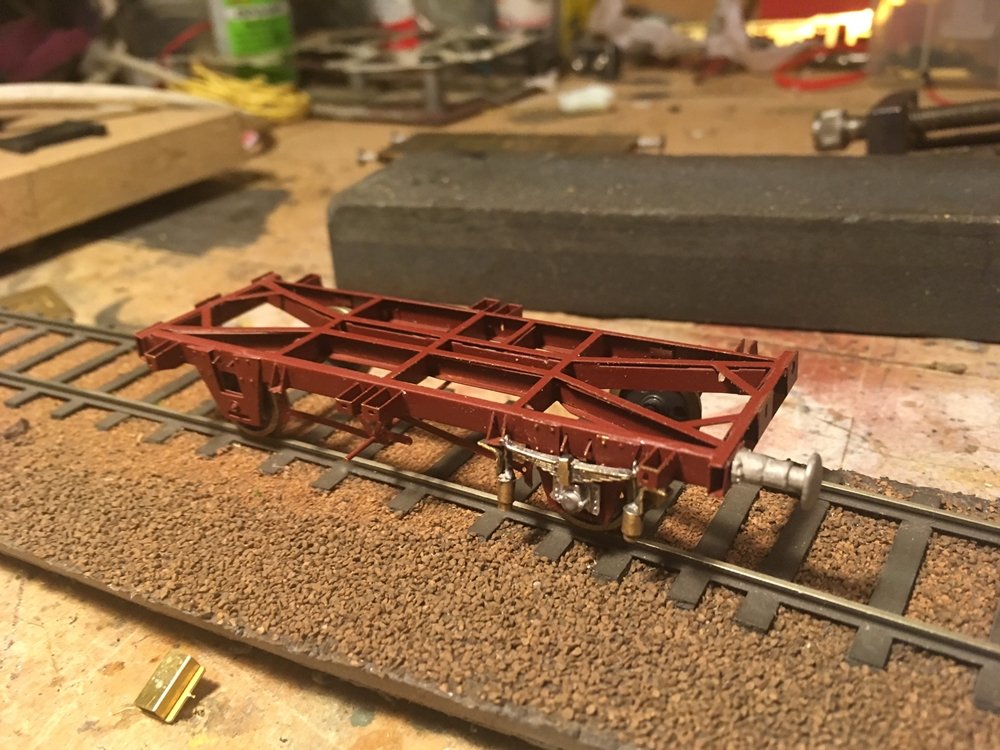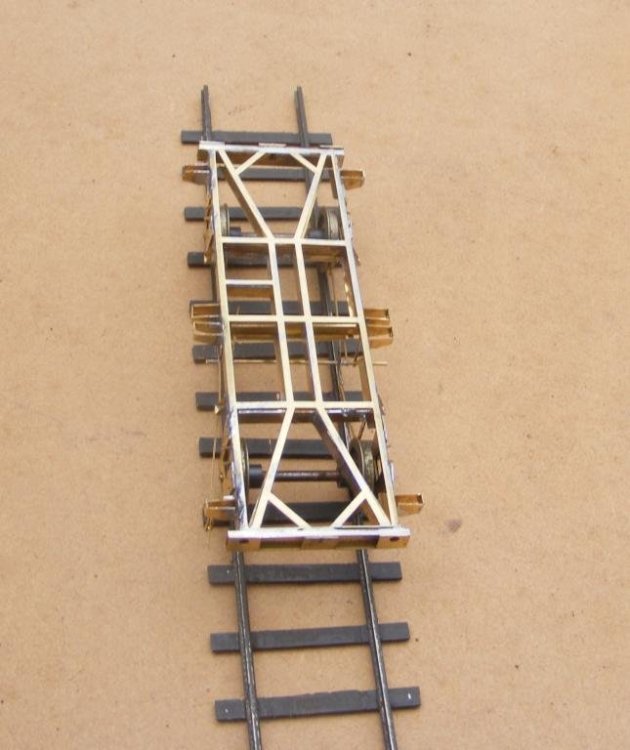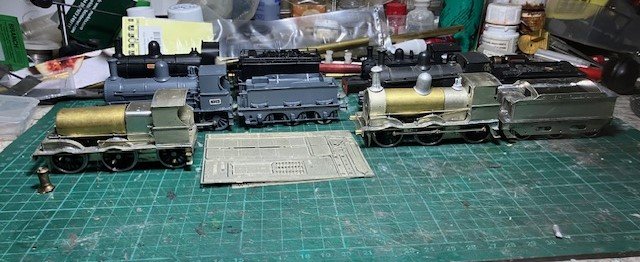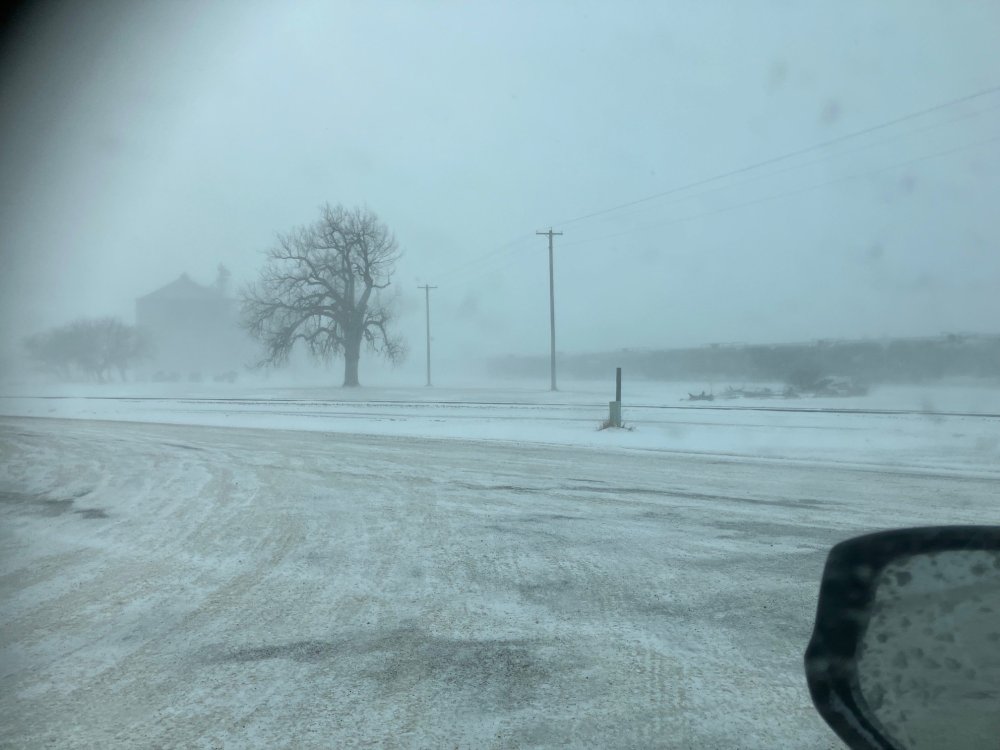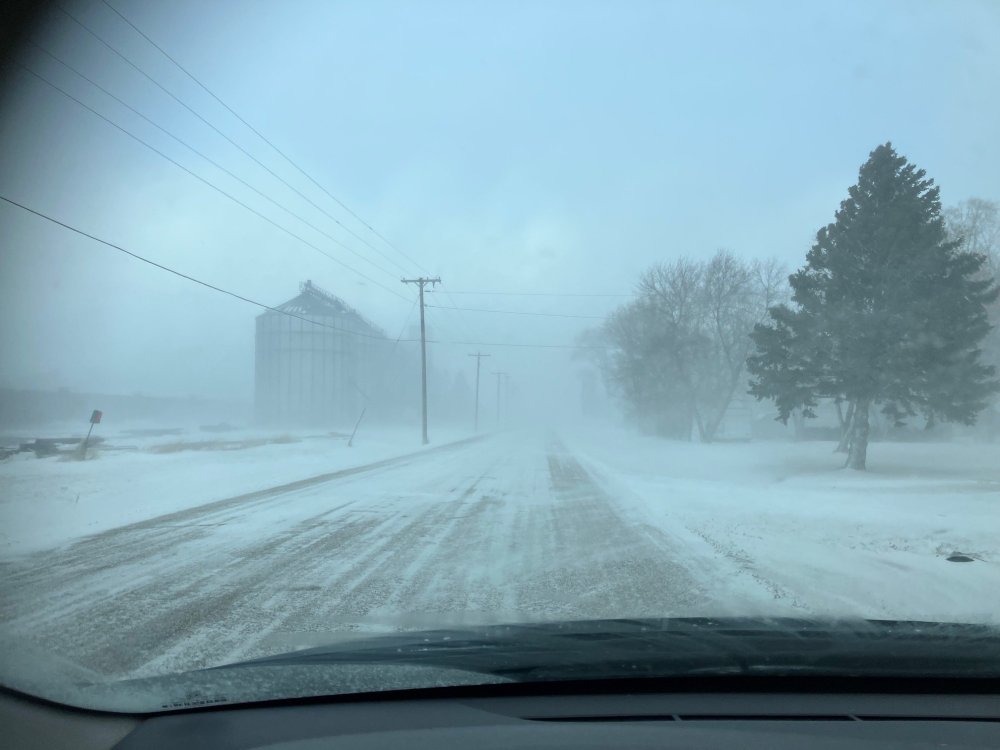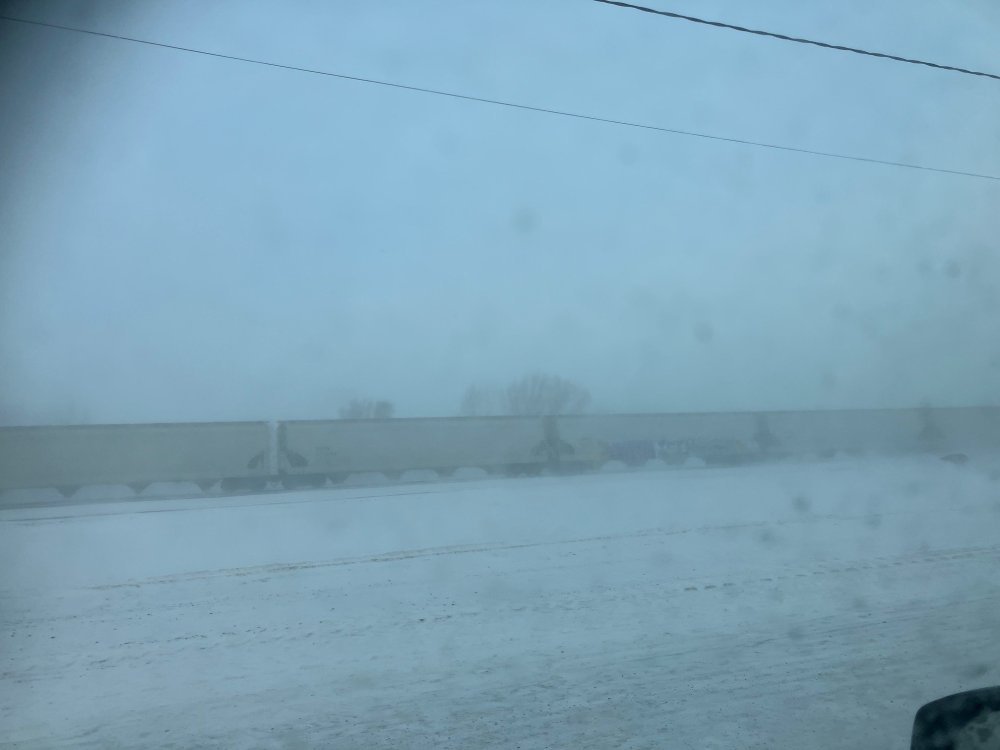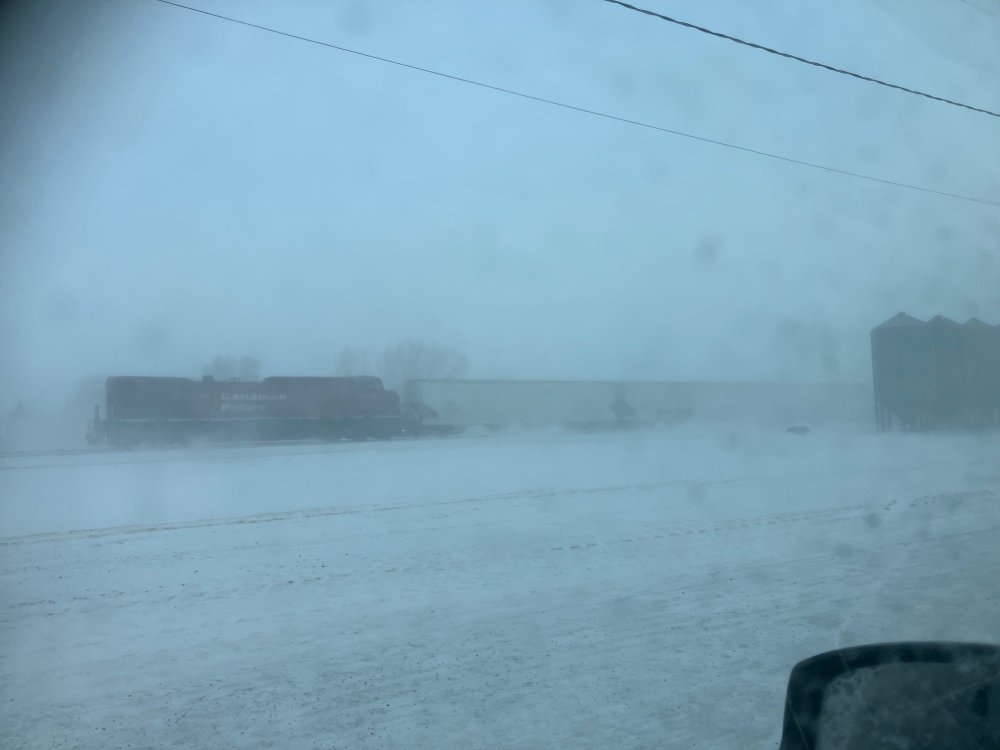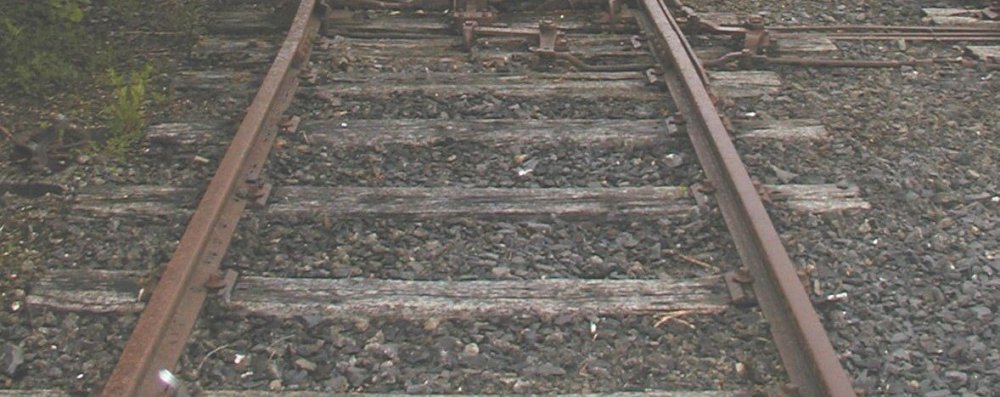-
Posts
4,861 -
Joined
-
Last visited
-
Days Won
119
Content Type
Profiles
Forums
Events
Gallery
Blogs
Store
Community Map
Everything posted by Mayner
-
"Back in the Day" Comet Models has a particularly striking exhibition stand that featured contemporary rtr British Outline steam outline locos whizzing away continuously on their replacement chassis and their beautifully finished coach kits with flush glazing at a time the majority of plastic rtr coaches had their glazing set behind relatively thick plastic sides. The TMD/SSM etched GNR, GSR and GSWR etched coach kits were a similar break through for Irish modellers, in the early 2000s Worsley Works began producing etched sides, ends and underframes for 'modern" Irish coaches including the AEC Railcars, Laminate, Park Royal and Cravens on a similar principal to the Comet Kits, but without a suitable roof extrusion or detail castings. The Railcars and Coaches build into nice models, but there models of a particular era and there are challenges particularly around the roof and sourcing suitable running gear/bogies. When I sourced the parts about 20 years ago my initial thoughts were to use an extruded roof similar to those used by Comet and other British manufacturers, but the $11k NZ -€6k price tag for a die to extrude a wider Irish profile coach roof put that particular idea to bed, instead I formed the AEC Railcar roof using balsa, glider tissue and dope, with lining tape jointing strips and cast whitemetal vents, I used standard Comet BRMk1 roof extrusions cut longitudinally widened to the Irish profile with the resulting gap filled with body filler supported on a plasticard jointing strip, followed by a lot of sanding before completing the roof detailing. Functional coach bogies were MJT "Torsion Bar" bogies widened to 21mm gauge, while the railcar runs on "Black Beetle' bogies supplied to 21mm gauge rtr. The main stuff up is the coaches run on BR pattern Commonwealth Bogies as no suitable castings were available and the MTK AEC railcar bogie sideframes are to a 9'6"" as opposed to the correct 10' wb resulting in a misalignment between the functional and cosmetic bogie sideframes. Ten or so years later when I began to design the Tin Van kits my initial thoughts were to use a 3D printed body core with etched cosmetic overlays, but ended up producing the vans as conventional etched kits as a result of the limitations of the 3D printing process and cost. While the large scale release of relatively inexpensive high quality rtr models has lead to a expectation that manufacturers like MM or IRM will produce rtr models of once common items of stock such as the AEC Railcars, Laminates, Tin Vans and the various Passenger Brake Vans, I still believe that there is a place for kit and scratch building as it may not be viable to produce some or all of these models as a result of the size of the market. This has been reinforced to a degree of the lower than expected demand for the forthcoming Intercity Railcars, recent sale of Bulleid Wagons and IRMs recent instruction to the factories to reduce minimum order quantities for some models. So what of the Worsley Works Irish coaching stock and what could be done to simplify its assembly, a number of New Zealand kit manufacturers have shifted to a multi-media approach combining laser cut, etched and 3D printing. 1. The issue of the wider Irish profile could be overcome by 3D printing the part possibly including basic detail such as jointing strips, including a domed end for AEC railcars. 2. A one piece 3D printed floor/ends & underframe including truss bracing and battery boxes as opposed to individual components. 3. A one piece 3D printed interior including partitions and seating. 4. 3D printed functional bogie suitable for 21mm or OO. Using etched coach sides as opposed to a fully 3D printed body eliminates the risk of print defects inherent in resin printing in particular both sides of a coach body with a near identical surface finish on both sides as opposed to 1 good and 1 bad (soft) side sometimes present with 3D printing. Just floating the idea around rather than actually planning to do anything at this stage.
- 11 replies
-
- 12
-

-

-
Brilliant model Alan, I guess I'll have to learn to stop worrying and fit a DCC chip to one of my 2-4-0s I wired a number of my 2-4-0s for DCC with a socket in the tender (similar motor and gearbox to yours) but ended up with fried chips, though they run fine on DC.
-
Authentically modelled Irish narrow gauge layouts appear relatively plentiful judging by the content of New Irish Lines over the past 10-15 years, though relatively few of the builders of these layouts post content about their modelling on social media. A high standard in all aspects of modelling is a common tread with finely detailed (often scratch or kit built) locos stock, buildings, structures, pw, signaling and scenic modelling. Irish narrow gauge layouts have been featured in a variety of scales from 16mm (live steam) down to 3mm with 4 mm predominating. Chris Romain's 10mm Scale Killybegs layout featured Nov 2016 NIL is particularly fine & realistic. The Donegal appears to be the most popular, possibly followed by the C&L and Dingle. Andy who posts on this Newsgroup is a prolific Irish Narrow Gauge modeller who exhibits a number of Donegal Layouts, Castlederg (CVBT) Arigna (C&L) Alan Gee's layouts include BurtonPort and Ballyshannon and has scratchbuilt locos from various lines including the CDR, CVR, Swilly and the original West Clare Bagnall 0-6-0T Simon de Souza produced a very fine model of Dromad station on the C&L and comissioned high quality kits of a no of different C&L wagons (Foxrock Models) The Chester Model Railway Society produced and exhibited the Dingle Layout currently on loan to the Blennerville visitor center, while Paul Titmuss produced a very fine model of Annascaul and Lispool before turning his attention to the CVR with a model of Clogher. A 4mm model of Schull also appeared at one time but I am unsure of the identity of the builder. On this Group Patrick produced a 3mm diorama of Capecastle on the Ballycastle line, David a CVR layout that's morphed into a CDR-Swilly layout, Galtymore produced a 3mm layout based on Kiltubrid on the C&L , meanwhile my 4mm Keadue C&L layout continues to atrophy in my home office to be dusted off occasionally No Irish narrow gauge layouts are not exactly scarce
-
In my experience with the G2 2-4-0 and D17 4-4-0 a greater preference among 4mm Irish outline customers for complete kits as opposed to a set of etched parts. Although I would have preferred to supply both locos as sets of etched parts, the majority of customers expected the locos to be supplied as complete kits and not prepared to buy a set of etched parts only. Based on sales of G2 & D17 kits its likely that there is demand for 10-12 complete kits of the D16 Class at a price point that will cover manufacturing but not design cost. Interestingly I produced 3 different versions of the G2 the late MGWR & GSR/CIE round topped boiler versions sold in broadly similar numbers, while demand for the Belpair Boiler version was significantly lower. Motorising and balancing a D16 on the principals used by Alan in his BCDR 2-4-0 and my G2 & D17 kits using a High Level Gearbox and a weighted tender should not be a significant issue.
-

Making an ‘E’ – the Maybach Diesel Model Assembly thread
Mayner replied to Mol_PMB's topic in Irish Models
A paper on the E401 & 421 Classes written from an drivers perspective by Dan Renehan appeared in an IRRS Journal during the late 70s/80s went into detail on the operation of both classes. The E401 Class were basically a "Southern" engine largly based at Inchacore, used on Kingsbridge pilot duties (Passenger & Goods) and for working Islandbridge Junction-North Wall Transfer Freights both as Train Engine & Banker. The E401s were replaced by 'main line' locos (often B101) as train engine on transfer freights and train loading reduced following a runaway at Island Bridge Junction after the brakes on a E401 failed while descending the grade from Cabra during the 1960s. The raised silencer cowling (& silencer) was removed from the majority of the class following an exhaust fire occurred when one of the Class was working hard as Inchacore Works shunter. Apparrently oil tended to collect in the silencer resulting in a smoky exhaust and tendency to catch fire. Ironically the loco that caught fire the last of the E401 Class to remain in service retained its silencer and exhaust cowl until scrapped. The E421s appeared to be considered a "Northern" engine allocated mainly to Connolly used for shunting at Connolly & North Wall and North Wall-Liffey Junction Banking duties and do not appear to have been used to haul North Wall Transfer Freights. Apparrently the hydraulic transmission on the E401 and E421 Classes were set up differently as a result of experience gained with the E401s. The transmission on the E401s was set up to allow the loco to accelerate and reverse direction quickly while shunting wagons while the E421 had a slower acceleration rate as a result of a high level of transmission wear experienced by the E401s shunting and operating transfer freights. Perhaps a case for different DCC decoder accelleration rates for the sub classes.. One snippet from the Inchacore 150s book is that a German diesel engineer rumored to have 'jumped ship" from a German warship before WW11 assisted in CIEs dieselisation programme a photo in the book of an ex-works E424 is titled Hans Tomalie's "tank engine", which may reflect the "Works" view of the E Class as replacements of the GSWR tank locos used on similar duties, -
There are a number of photos of Meath Line passenger trains in the 1930s in"Great Southern Railways" Donal Murray published by Iain Allen during the 2000s as part of series of Irish railway pictorials. Before the Emergency there were usually 2-3 return passenger trains between Dublin & Kingscourt, that was possibly down to a single morning Kingscourt-Amiens St train & evening return working. 1930s photos of the train 3 ex-MGWR 6wheel coaches hauled by an ex-MGWR 2-4-0 or 0-6-0. In MGWR & GSR days there was a daily scheduled North Wall Kingscourt Goods likley to have been worked by an ex-MGWR Standard Goods, goods services were cut back to a three day weekly from the late 1940s usually worked by one of the large ex-MGWR Cattle Engine. At one stage brick traffic from the local brickworks was once an important traffic, at one stage there was a private siding into the works, though in later years wagons were loaded on the main line South of the level crossing. The station appears to have been a railhead for both passenger and goods traffic for Baileborough, in GSR days there was a glazed canopy on the gable end at the North end of the station building possibly as a shelter for passengers transferring from rail to road.
-

"Voiding the Warranty" - Mol's experiments in 21mm gauge
Mayner replied to Mol_PMB's topic in Irish Models
One wagon per fret due to the orientation of the sheet. The photo engraver charges a flat rate per sheet and a min charge of £9 for UK shipping. There is also a version with Bill Bedford style springing which did not reach the prototype/test etch stage http://www.clag.org.uk/bb-w-irons.html . I will check pricing next week as its over 10 years since I prepared the initial test etch. -

"Voiding the Warranty" - Mol's experiments in 21mm gauge
Mayner replied to Mol_PMB's topic in Irish Models
-
More of a taking stock and prioritising for 2025 than a workbench, I have very little time available for modelling for the next year or so as a result of family committments. First priority is to complete a pair of 21mm gauge J15s started several years ago as a low priority 'standby' project as potential motive power for a Burma Road layout if I ever get round to building it, failing that find a space in a display case. Although both kits were originally complete, I managed to mislay the coupling rods and some of the gearbox parts for the superheated loco. I have a set of rods from a spare chassis fret, though I will probably end up replacing the gearbox as its an old pattern High Level Load Hauler and replacement gears my no longer be available. Apart from assembling the replacement the rods, next job is to fit the brake gear to both locos and small GSWR tender before completing detailing before I loose any more parts. Next priority is to assemble a set of etched parts for a GSWR 60 Class 4-4-0 I designed in Jan 2024 and had in stock since last March! The 60 Class worked Limerick-Sligo passenger trains until replaced by AEC railcars during the 1950s. Locos final priority, if I get round to it! 21mm gauge 650 Class. Although I completed a couple of 21mm test builds and completed a number of OO RTR commissions, I have not completed a 21mm gauge 650 for myself. Body assemby on both locos is basically complete, though require fitting with an operating chassis. One of these locos will use Sharman wheels re-cycled from my first attempt at a 650 Class in 1985 but fitted with a more modern gearbox and motor. Coaching Stock, I have 4 SSM GSWR 6wheelers of different types & GSR decals stashed away to compliment my pair of assembled GSWR 6 wheelers.
- 392 replies
-
- 12
-

-

-
Its possible that some of the issues experienced with currencies and billing may be related to Shopify/Shop-pay systems issues and may be largely outside the control of individual merchants like IRM. I have experienced similar issues with currencies both as a merchant and as a customer, both as a result of changes in Shopify terms and conditions and software issues. Before Christmas a US 'Narrow Gauge Shopify site 'thought" I was in South Africa and quoted prices in Rand until I reached the check out and 'realised" that I was in New Zealand, and would not accept a US delivery address as an alternative to the address on the "Shoppay" system. I had been looking forward to buying a rare Rio Grande Southern book and finding myself buying the book but unable to change the delivery address. It turned out ok in the end the seller providing a refund the book was out of stock and managed to source a replacement theough Amazon Marketplace at a lower price, the seller being a library support group from the Pacific NorthWest so not a bad ending. One of the issues with the Shoppay system is that it retains the customers credit-debit card details for use on Shopify transactions, although I received an IRM invoice for a pre-order of Grain Wagons, Shoppay automatically debited my account after IRM issued the invoice rather than my pressing the "pay-now" button on the invoice I have no problem with the price or shipping cost of the wagons which are a good bargain. I guess my problem is with the insidious nature of the current generation of electronic payment systems which are eroding consumer control.
-
Had an interesting experience with DHL couriering an important document to the States over the Christmas New Year period. Document was supposed to have been collected by DHL in New Zealand on Christmas Eve then silence until 6th Jan when they actually collected the document when the sender's office re-opened after the Christmas break. DHL handled the international air side in 3 days from Auckland to their Minnesota hub before handing over to their "local partner" for delivery (525miles) receiving "out for delivery" notifications for 3 days, before receiving a notification that the item was delivered at 03:00 on Sunday morning! Followed up with the sender for proof of delivery and were assured that the document was placed in our (non-existent) mailbox by DHLs delivery partner United States Postal Service. It turned out that the document was delivered to our families PO Box at the local post office although addressed to our physical address. I guess the mail van did the cities (500pop) mail drop during the early hours of Sunday morning before driving to the next city in the State. At the end of the day the document arrived just in time.
-
It looks like some Bredin Coaches dating from the 1930s and non-Laminate stock appeared in silver. 1. The 1st 'silver coach' in the railcar set in the Killiney photo appears to be a Bredin Suburban coach (rainstrip & window/door arrangement main spotting feature). These coaches were built with steel body panels so possibly a re-paint as Bredin coaches which passed to RPSI retained their steel body panels until withdrawn from service in the early 1970s. 2. The coach behind 260 appears to be a Laminate Suburban coach which were converted to Brake Stds during the early 702 3.The TPO (built late 50s) appears to have aluminium body panels on traditional timber body framing. The body sides would have had to be near vertical above the tumblehome for the mail sorting racks, the 4w PO vans had a similar body profile, while the Tin & "Hooded Vans" had the teardrop body profile similar to the majority of Laminate coaches. Main spotting difference between Liminate and conventional timber framed stock, was the Lainates were built with full height body panels (which included windows) with vertical coverslips between adjacent panels, without the horizontal coverslip at waist height used on conventionally built stock.
-
My first train photos of 2025, been a bit cold so far for lineside photos. But heared the whistle of an Eastbound CP fraight as I returned home from the grocery store. I didn't get a photo of the head end power as I struggled with the screenlock on my iPhone but managed to catch the tail-end power the majority of CP & BNSF through freights in this part of the World are now run topped-& tailed Fairmount looking West Demson Grain Inc elevators in distance. Oil Tank cars set out on spur for/from local oil terminal. Line in centre of photo is spur connecting CP (Soo Line) with local fuel and fertiliser terminal. 20 or so years ago an 'old man" lived in a dilipadated two storey house and had a vegetable garden in the area between the trees, these days the remains of his cars/trucks and furnace (heating boiler) remain. Fairmount looking East. Grain terminal which includes original Elevator occasionally dispatches grain by rail. The original CP Depot is likely to have been in this area, tank cars on through freight barely visible. Centreflow Hopper cars in through freight. Designed for carrying lightdensity products including plastic pellets. Tail end power a General Electric 4400hp+ unit which has tended to be the main stay of motive power on the CP/SOO line in this area during the past 20 odd year. The ex-SOO line is fairly easily graded with a single large GE unit heading most trains, biggest change during the past 20 years has been the conversion of the SOO line from unsignalled 'Dark Territory" to CTC & the running of less frequent heavier freights following the introduction of "Precision Railroading" where freights run to a schedule as opposed to 'Extras" based on traffic/customer demand. In unsignalled 'dark territory" trains movements were controlled by TWC where instructions (Track Warrants) were transmitted by radio by a Dispatcher to Train Crews an updated version of Telegraph and Train Order control of the 19th Century. TWC was excellent for enthusiasts listening in with a radio scanner as not only could you find out what trains were running, but also loco number, engineering posessions, train crews and dispatchers.
-
- 3
-

-
The diagram was drawn in DesignCAD a drafting programme I have used for about 25 years. AutoCAD and other Autodesk software may be a better option, being an industry standard for 2&3D design & free to students https://www.autodesk.com/education/home AutoCAD is suitable for 2D drawing/drafting, TinkerCAD & Fusion for 3D modelling/printing
-

Ernies Massive Irish 1930's to 2005 Photo Archive
Mayner replied to Glenderg's topic in Photos & Videos of the Prototype
Bertram Mills used a Circus Train to tour Ireland during the early 60s an A Class was used for haulage on CIE and a UG for the Belfast-Bangor. Dan Renehan may have written about an A Class hauling the very heavy circus train over Barnagh on the North Kerry without slipping in one of his IRRS papers, there is a colour photo of the train on the Bangor line in one of the "Irish Raiways from Steam to Diesel published by Tom Middlemas during the mid 1990s. -

Ernies Massive Irish 1930's to 2005 Photo Archive
Mayner replied to Glenderg's topic in Photos & Videos of the Prototype
ber -
There are some interesting photos of Fenit Pier in the Kennelly Archive, they appear to have continued in after the gantry was installed in the late 60s https://www.kennellyarchive.com/-/archive/all-images/-/medias/d50d6827-9e27-43d2-b28e-0d1268e9f5a2-cranes-at-fenit/fs One of the steam cranes unloading a (coal) boat into a cut of railway wagons on the parrallel siding. https://www.kennellyarchive.com/-/archive/all-images/-/medias/1cedefcc-b639-434c-9175-7cbe5b85c05c-cranes-at-fenit/fs "Leibherr Ireland" Gantry crane apparrently loading Tower Crane jib sections onto a ship, crane components and structural steelwork in stacking area. https://www.kennellyarchive.com/-/archive/all-images/-/medias/9da0e68a-6d8a-40ce-bd7d-50b5129c1b75-cranes-at-fenit/fs General view of Pier with two steam cranes and gantry crane. https://www.kennellyarchive.com/-/archive/all-images/-/medias/2f0fb9d1-9f79-44ed-b526-0b3a42e42a65-sea-angling-competition/fs Angling competition 69 three steam cranes in background, no couplers or buffing gear. It looks like the steam cranes may have been mainly used for unloading coal boats, using tub like skips loaded by hand by workers in the ship's hold, a mobile crane with grab was trialed in 1965 for loading trucks https://www.kennellyarchive.com/-/archive/all-images/page/175#media_6edb0e7f-e29b-4aec-a32c-4487f6206210 I had plans to convert a HO Jordan Steam Shovel into a crane for my own dock line (if I ever get round to it) https://www.hobbylinc.com/jordan-erie-b2-steam-shovel-plastic-model-kit-ho-scale-303 Its possible the G Class was used for working wagons between Fenit Yard and Pier with a 'main-line" loco working trains between Fenit & Tralee rather than a G611. In pre-CIE days a small 'industrial" 0-6-0ST is likely to have been used for similar duties and an ex WLWR or GSWR loco for 'main line' work to and from Tralee.
-
I first heard 007 being nicknamed James Bond while travelling on a IRRS special to Youghal in 77-78. The return leg of the special was blocked at Thurles as a result of the evening Cork-Heuston failing near Templemore. 007 on Pilot duty was dispatched 'wrong road" to Templemore and hauled the crippled train to Heuston. 007 seems to have been in fine fettle, after an initisl delay of about half an hour we had a clear run without a signal check all the way to Islandbridge Junction. At the time Ballybrophy was the fringe box for Cork Line CTC, Thurles still functioned as a loco depot (beet season) and pilot workings & Pilot Loco's were available at several depots to cover failures.
-
Fenit was feaured in one of Michael Baker's annual Irish Railway World aricle in the early 70s, only rail traffic from the Port was a train load of starch after a ship was diverted to Fenit as a result of a storm. Seasonal beet working continued to run to Fenit unil 1977, rail connection to he quay was disconnected in connection with a sewrage scheme when i visited in 78. Intteresingly one of Feinits main businesses as a port has been exporting Leibherr Container and Port cranes.
-
Australian modellers take on the pros & cons of modelling the 5'3" broad gauge in HO on HO or EM gauge track. https://armchairmodellerdownunder.blogspot.com/2012/03/australian-ho-broad-gauge.html. There was a lot of simularility between Queensland Railways and CIE effectively becoming General Motors railways at a time other Australian railways were buying 'British. The QR T Class referred to in the piece was a pre-cursor and close relative of the EMD GL8 or CIE B121 Class. Personally while the availability of EM track appears to be an advantage this is more than offset by the almost complete absence of suitable 4mm locos and stock in either rtr or kit form, there is also the little matter of EMGS track being to a different (larger) scale than the rest of the model.
-
Lima produced its first Irish trainsets in HO during the 1970s using British outline stock a Class 33 diesel , a 4f MK1 & 2 coaches. Crude by todays rtr standards (HO lenght height/OO width)I don't recall if anyone attempted to model 5'3" in HO . Thought of Ballyconnell Road but its 3mm fine scale standards, essentially a 3mm Adavoyle complete wittth steam outline locos with working inside valve gear.
-
For much of the 20th century the majority of traditional jointed flatbottom track used on Irish main and secondary lines was laid on cast iron baseplated and fixed with fang-bolts (bolt with a large integral washer) to timber sleepers rather than with spikes. Photo from Kiltimagh on the Burma Road, though same baseplate and fixing detail used on the majority of lines laid with FB rail on the CIE system though rail section and baseplate size may vary. e.g 85Lb & 90Lb rail shared the same foot & baseplate width, 95Lb used onmore heavily trafficed lines had a wider foot & baseplate width. A 3D printed track system with a integral baseplate would assist in gauging the track, possibly with a trackpin as 'spike", interestingly American modellers where handlaid track still remains popular spike every 5th tie/sleeper.
-
Its possible that the open topped container/framework were intended to safely carry Lancashire Flat swap bodies popular for Irish Sea unit load traffic in the 60s. B&I Cork-Dublin Liner/Container train was introduced in 1969 following B&I withdrawl of Cork-South Wales freight services, the photo at North Wall indicate that B&I Lancashire flats overhung both the sides and ends of a 20' road trailer. Its possible that the 'framework' containers were a quick fix for handling existing Lancashire Flats until sufficient ISO flats became available. The bagged Fertilier swap body appeared during the late 60s and operated on 20 wagon "Back to Back" fertiliser trains until supreceeded by the bogie wagons in the mid-70s. Sometimes both Bogie and Back-to Back fertiliser wagons ran in the same train, I remember an empty fertiliser made up mainly of bogie wagons with a single Back to Back at the tail end passing Dunlaoire at speed in the 70s with a noticeable jolt as the 4wheeler ran through a facing point.
-

Provincial Wagons CIE cattle wagon - 21mm gauge advice needed
Mayner replied to Mol_PMB's question in Questions & Answers
SSM once produced etched w irons suitable for 21mm gauge and a separate single lever brake gear fret W irons could be set up to assemble a rigid or compensated chassis Best conact Whesty on this forum to check availabiliy. Another alternaive is to widen OO/EM/P4 w-irons b. soldering in a srip of brass, (I used his mehod on 21mm sock built in the early 90s -

Claremorris Train Crash September 1989
Mayner replied to Noel's topic in What's happening on the network?
The CIE/LHB joint venture proposal appears to be based on the assumption of manufacturing coaches for export in addition to CIEs own needs. Not unlike Leibherr manufacturing cranes for export in Killarney since the 1960s. Coaches would have been LHB design most likely Continental rather than British outline similar to the "Dutch Vans' & LHB DART Units. Export stock likely to be built to suit the customers loading and track gauge.
.png.c363cdf5c3fb7955cd92a55eb6dbbae0.png)

